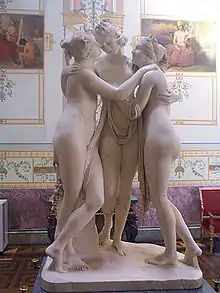Euphrosyne
In ancient Greek religion and mythology, Euphrosyne (/juːˈfrɒzɪniː/; Ancient Greek: Εὐφροσύνη), was a deity, one of the Charites, known in ancient Rome as the Gratiae (Graces). She was sometimes called Euthymia (Εὐθυμία) or Eutychia (Εὐτυχία).[2]
| Euphrosyne | |
|---|---|
Goddess of good cheer, joy and mirth | |
| Member of The Charites | |
 A statue of Euphrosyne in Achilleion palace, Corfu. | |
| Affiliation | Aphrodite |
| Major cult centre | Boeotia |
| Abode | Mount Olympus |
| Personal information | |
| Parents | Zeus and Eurynome Nyx and Erebus[1] |
| Siblings | |
Family
According to Hesiod, Euphrosyne and her sisters Thalia and Aglaea were daughters of Zeus and the Oceanid Eurynome.[3] Alternative parentage may be Zeus and Eurydome, Eurymedousa, or Euanthe;[4] Dionysus and Kronois;[5] or Helios and the Naiad Aegle.[6]
In some accounts, Euphrosyne was a daughter of the primordial gods, Erebus (Darkness) and Nyx (Night).[7]
"From Nox/ Nyx (Night) and Erebus [were born]: Fatum/ Moros (Fate), Senectus/ Geras (Old Age), Mors/ Thanatos (Death), Letum (Dissolution), Continentia (Moderation), Somnus/ Hypnos (Sleep), Somnia/ Oneiroi (Dreams), Amor (Love)--that is Lysimeles, Epiphron (Prudence), Porphyrion, Epaphus, Discordia/ Eris (Discord), Miseria/ Oizys (Misery), Petulantia/ Hybris (Wantonness), Nemesis (Envy), Euphrosyne (Good Cheer), Amicitia/ Philotes (Friendship), Misericordia/ Eleos (Compassion), Styx (Hatred); the three Parcae/ Moirai (Fates), namely Clotho, Lachesis and Atropos; the Hesperides."[8]
Mythology
Euphrosyne is a goddess of good cheer, joy and mirth.[9] Her name is the female version of the word euphrosynos, "merriment". Pindar wrote that these goddesses were created to fill the world with pleasant moments and good will.[10] The Charites attended the goddess of beauty Aphrodite.[11]
In art, Euphrosyne is usually depicted with her sisters dancing.[9]

Legacy
In art and literature

- Euphrosyne is depicted with the other two Graces, Aglaea and Thalia, at the left of the painting in Botticelli's Primavera. The sculptor Antonio Canova made a well-known piece in white marble representing the three Graces, in several copies including one for John Russell, 6th Duke of Bedford.[13]
- Joshua Reynolds painted Mrs. Mary Hale, wife of General John Hale, as Euphrosyne in 1766.
- John Milton invoked her in the poem L'Allegro.[14]
- Virginia Woolf set her novel The Voyage Out on a ship named Euphrosyne.
In science
- The asteroid 31 Euphrosyne is named after the goddess, as is the Euphrosinidae family of marine worms.
- Augustin Pyramus de Candolle named a genus of plants in the family Asteraceae Euphrosyne.
Notes
- Hyginus, Fabulae Preface
- Pindar, fr. 155
- Hesiod, Theogony 907
- Cornutus, Compendium of Greek Theology 15
- Nonnus, Dionysiaca 15.87 & 48.530
- Pausanias, 9.35.5
- Hyginus, Fabulae Preface
- Hyginus, Fabulae Preface
- Larson, Jennifer (2007). Ancient Greek Cults. New York, NY: Routledge. pp. 162–163. ISBN 978-0415491020.
- Pindar, Olympian Ode 14.1-20
- Homeric Hymn 5 to Aphrodite 58
- "www.britannica.com". Retrieved 2016-08-31.
- The Three Graces. Victoria & Albert Museum, 2013. Retrieved 2 May 2013.
- "Milton, L'Allegro and Il Penseroso"
References
- Hesiod, Theogony from The Homeric Hymns and Homerica with an English Translation by Hugh G. Evelyn-White, Cambridge, MA., Harvard University Press; London, William Heinemann Ltd. 1914. Online version at the Perseus Digital Library. Greek text available from the same website.
- Nonnus of Panopolis, Dionysiaca translated by William Henry Denham Rouse (1863-1950), from the Loeb Classical Library, Cambridge, MA, Harvard University Press, 1940. Online version at the Topos Text Project.
- Nonnus of Panopolis, Dionysiaca. 3 Vols. W.H.D. Rouse. Cambridge, MA., Harvard University Press; London, William Heinemann, Ltd. 1940-1942. Greek text available at the Perseus Digital Library.
- Pausanias, Description of Greece with an English Translation by W.H.S. Jones, Litt.D., and H.A. Ormerod, M.A., in 4 Volumes. Cambridge, MA, Harvard University Press; London, William Heinemann Ltd. 1918. ISBN 0-674-99328-4. Online version at the Perseus Digital Library
- Pausanias, Graeciae Descriptio. 3 vols. Leipzig, Teubner. 1903. Greek text available at the Perseus Digital Library.
- Pindar, Odes translated by Diane Arnson Svarlien. 1990. Online version at the Perseus Digital Library.
- Pindar, The Odes of Pindar including the Principal Fragments with an Introduction and an English Translation by Sir John Sandys, Litt.D., FBA. Cambridge, MA., Harvard University Press; London, William Heinemann Ltd. 1937. Greek text available at the Perseus Digital Library.
- The Homeric Hymns and Homerica with an English Translation by Hugh G. Evelyn-White. Homeric Hymns. Cambridge, MA., Harvard University Press; London, William Heinemann Ltd. 1914. Online version at the Perseus Digital Library. Greek text available from the same website.